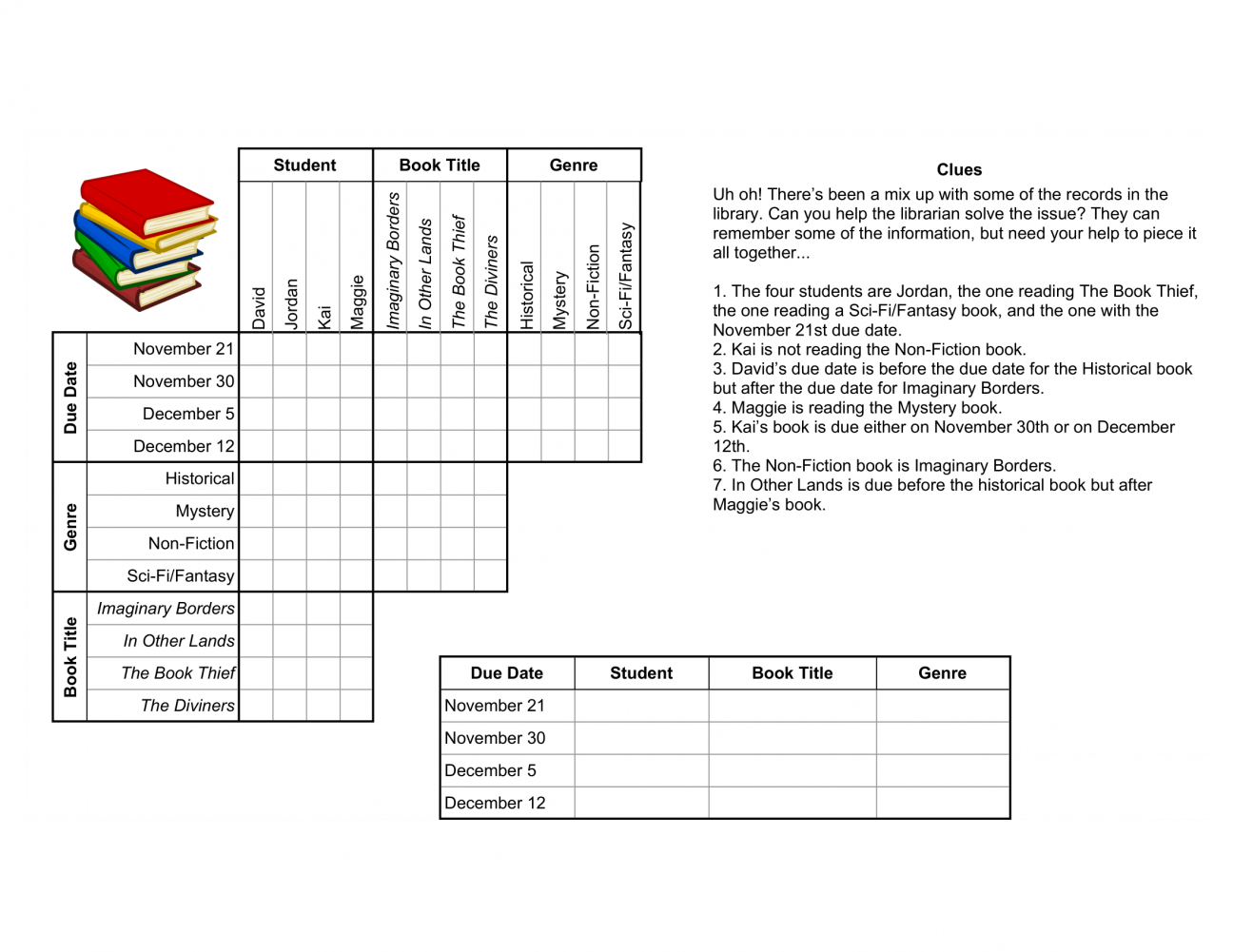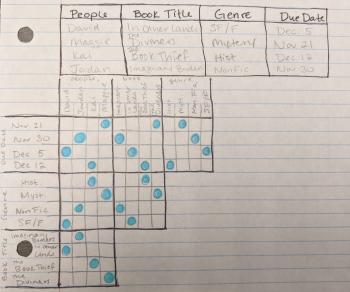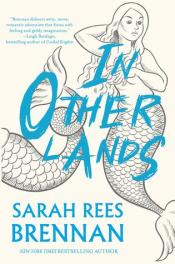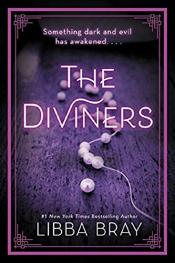Despite what your school might have you think, logic grid puzzles aren't reserved solely for math classes. They can be a lot of fun and apply to anything from tattoos to fandoms. But, if your brain works like mine does, it might be easier to create your own logic grid puzzle than solve one that someone else made. Below, I've written up some basic instructions for how I usually go about creating my logic puzzles, along with an example that I whipped up in about an hour.
If you want to try to solve the Library Logic Grid Puzzle yourself, do so now! The rest of this blog contains spoilers for the correct answers.
Library Logic Grid Puzzle

I like to do the first few steps by hand, because that's the easiest way for me to visualize how my logic grid puzzle is taking shape. But you could easily do this in a document or spreadsheet on the computer if that's more your style.
To start, you'll want to pick four (or more!) categories. Since mine was about a library, the categories I chose were: people (later renamed students), book title, genre, and due date. Once I had decided on the categories, I had to fill in each entry for each category; to make my life simple, I went with four entries as well. That being said, you can choose as many categories and/or entries as you'd like! Just be aware that the more components you add, the more difficult the puzzle will be for people to solve.


Once I had all of my entries filled in, I drew a little chart with the category titles on the top row, and decided how everything lined up (that's what the checkmarks are for in the second photo above). Having a table with your answers can be the easiest way to keep everything straight as you start to create your grid and write your clues. For my grids, I usually write all the entries in alphabetical order within each category.
You'll want to pay attention when laying out your grid: the same category can't overlap on itself, so you'll have to reverse the order of the categories along one axis. For instance, the categories along the top go "People (Students), Book Title, Genre," while the categories down the side go "Due Date, Genre, Book Title." As you might have noticed, two of the categories repeat (book title and genre) while two don't (students, due date). This is so people solving the puzzle can see the overlap of all the categories, rather than trying to keep it all straight in their head.
As you can see below, I also drew by hand a rough sketch of the grid; I know that that isn't for everyone, though, and so I've also included a template for a 4x4 grid, which you can print and fill in yourself!


(Just right click on the template, choose "Open Image In New Tab"/"View Image"/etc., and print your logic puzzle from there. The image quality is high enough that you shouldn't have a problem with a printed version! If you want to create your own editable grid, I would recommend Microsoft Excel or Google Sheets (I used Google Sheets); the flexibility to create as many categories and entries as you need is really great compared to finding one online and filling it in via Photoshop or another program (or by hand).)
It's okay if you mess up a few times when practicing at first—I had to test three different versions of my grid, reordering slightly with each version (I ended up cheating a bit in the end, and included the The in two of the book titles so the answers didn't line up too perfectly). Again, this might be easier to do on a computer or with a pre-made grid; whatever works for you is just fine!
The last stage—and definitely the most difficult, in my opinion—is creating the clues that will help others solve your puzzle. Thankfully, there are resources online to help you navigate this part of the process. The one I like to use is Puzzle Baron's How To Solve a Logic Puzzle. Even though this is technically meant for solving puzzles, it can really inform the puzzle creation process as well. For instance, in the tutorial they cover the different types of clues: true/false, multi-elimination, neither/nor, either/or, greater/lesser than, and unaligned pairs. You can click the link for more details on each section, but I've included all the clues for my Library Logic Grid Puzzle below, along with what type of question it is.
- The four students are Jordan, the one reading The Book Thief, the one reading a Sci-Fi/Fantasy book, and the one with the November 21 due date. Multi-Elimination
- Kai is not reading the Non-Fiction book. True/False
- David’s due date is before the due date for the Historical book but after the due date for Imaginary Borders. Greater/Less Than
- Maggie is reading the Mystery book. True/False
- Kai’s book is due either on November 30 or on December 12. Either/Or
- The Non-Fiction book is Imaginary Borders. True/False
- In Other Lands is due before the historical book but after Maggie’s book. Greater/Less Than
There's no required number of clues; some puzzles will have more, and some will have less. It can also depend on how much detail you cram into one clue—a multi-elimination will tell you a lot more than a true/false, in the long run.
And there you have it! You've created your own logic grid puzzle! If you're worried about whether or not it can be solved by someone who doesn't know all the answers ahead of time, try running it by a friend or family member, to see if they can figure it out too.
And, finally, if any of the (real!) books I included in the puzzle sound intriguing, you can check them out in our catalog. Just click on one of the photos below to check out an eBook from OverDrive or place a hold on a physical copy:

Imaginary Borders by Xiuhtezcatl Martinez
"In this personal, moving essay, environmental activist and hip-hop artist Xiuhtezcatl Martinez uses his art and his activism to show that climate change is a human issue that can't be ignored."

In Other Lands by Sarah Rees Brennan
"Despite his aversion to war, work, and most people (human or otherwise), teenaged Elliott, a human transported to a fantasy world where he attends a school for warriors and diplomatic advisers, finds that two unlikely ideas, friendship and world peace, may actually be possible."

The Book Thief by Markus Zusak
"Trying to make sense of the horrors of World War II, Death relates the story of Liesel—a young German girl whose book-stealing and story-telling talents help sustain her family and the Jewish man they are hiding, as well as their neighbors."

"Seventeen-year-old Evie O'Neill is thrilled when she is exiled from small-town Ohio to New York City in 1926, even when a rash of occult-based murders thrusts Evie and her uncle, curator of The Museum of American Folklore, Superstition, and the Occult, into the thick of the investigation."